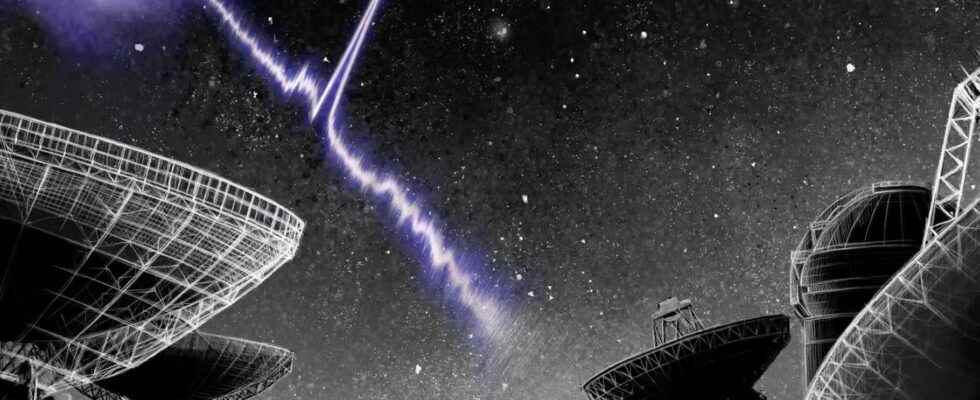We know that we entered the era of gravitational astronomy in 2015, almost 100 years after Albert Einstein’s complete shaping of his relativistic theory of gravitation, the famous theory of general relativity. She describes thespace-time as an elastic and therefore deformable medium, capable of vibrating and oscillating like the surface of water and even of transforming itself into the equivalent foam in the regime dominated by quantum effects.
The gravitational waves can be issued by all distributions of matter which are described by what the physicists call, in their jargon, quadrupoles, which is not the case for all sources. Thus, a star that would explode in a perfectly spherical fashion would not produce gravitational waves. On the other hand, it is indeed the case of a couple ofstars in orbit around each other, like the Earth and the Moon. I’episode is however strong only with compact stars, like black holes and neutron starsand especially when they are about to collide and merge.
Just like the light stars gives us valuable information on phenomena and objects in astrophysics, “gravitational light”, so to speak, is rich in information, all the more so if we can combine these two types of messages and that is also in this way that it has been demonstrated that certain gamma-ray bursts were indeed, as we thought, collisions of neutron stars producing what are called kilonovae.
A video presentation of Virgo and the hunt for gravitational waves. © CNRS
From kilonovae to FRBs
Encouraged by these results, the members of the collaborations Ligo and Virgothe now famous gravitational wave detectors, set out to try to shed light on the nature of the still enigmatic fast radio bursts (Fast Radio Burstsor FRB, in English) by trying to detect gravitational waves that could be associated with them, as they explain in an open access article on arXiv.
Also called “Lorimer bursts”, named after their discoverer, FRBs are transient signals where the equivalent of all theenergy radiated by the Sun in the visible for a year seems to be released in a few milliseconds at most in the radio domain. It was thought at the beginning precisely that they could be associated with explosions of supernovae and collisions of compact stars, for example a neutron star with a black hole, but the discovery of repeating FRBs for the same source on the celestial vault (this is however not the case for all FRBs) has demonstrated that could not be the case. We know all the same today that they are located billions oflight years of the Milky Way and there are indications that they might be related to magnetarsthese neutron stars with magnetic fields particularly intense.
Since 2018, with the inauguration of a new radio telescope scale at the Dominion Radio Astrophysical Observatory in British Columbia, Canada, the astrophysicists had a tool particularly suitable for detecting FRBs and it quickly made it possible to detect hundreds of them. Called the Canadian Intensity Mapping Experimenthydrogen », or, in English, Canadian Hydrogen Intensity Mapping Experimentshort for Chime.
A presentation video of the Chime radio telescope. To obtain a fairly accurate French translation, click on the white rectangle at the bottom right. The English subtitles then appear. Then click on the cogwheel to the right of the rectangle, then on “Subtitles” and finally on “Translate automatically”. Choose “French”. © McGill University
Nowadays, we know quite well how to locate FRBs on the celestial vault and by studying the effect on their spectra radio of the interactions of the signal emitted with the electrons free in the observable cosmos, we can derive a distance to the Milky Way. The longer the travel time, the greater the difference between the arrival time of the radio pulses in the high and low parts of the spectrum of these pulses.
The combination of the Ligo and Virgo detectors also makes it possible to locate a source of gravitational waves on the celestial vault and therefore to do multi-messenger astronomy as we say, in this case to see if an electromagnetic signal is associated with a gravitational signal. with two sources that coincide on the celestial vault.
Thus, about 350 FRBs had provided data that could be linked to Ligo and Virgo. The researchers therefore reviewed the data recorded by these two instruments during a detection campaign that took place between April and September 2019.
Two different detection methods have been implemented, as explained in a press release from the Ligo and Virgo collaborations. The first focuses on coincidence detection only between two sources and the second is based on the fact that we know a priori the general shape of the spectrum of the waves emitted by collisions of compact stars. The first method is therefore independent of certain assumptions about the nature of FRBs and the second is not, and it applied only to non-repeating FRBs.
Thirty-nine FRBs were studied with the first method and twenty-two with the second. The results are currently negative but this does not mean that they will remain so because a gravitational signal may not be detectable for close FRBs. The sensitivity of the detectors of these waves increases over time, we could end up having good surprises and it is for this reason that research of this type will continue, already in the data that will be collected in the next six months with Ligo and Virgo.
Interested in what you just read?
